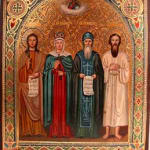Four Saints, 19th Century CE
Oil on Wood Panel
12.25
PF.5985
Further images
Russians inherited the tradition of icon painting from Byzantium, where it began as an offshoot of the mosaic and fresco tradition. During the 8th and 9th centuries, the iconoclastic controversy...
Russians inherited the tradition of icon painting from Byzantium, where it began as an offshoot of the mosaic and fresco tradition. During the 8th and 9th centuries, the iconoclastic controversy in the Orthodox Church called into question whether religious images were a legitimate practice or sacrilegious idolatry. Although the use of images was in the end permitted, a thorough distinction between profane art intended to depict reality and sacred art designed for spiritual contemplation was established. That difference is one of the reasons that the artistic style of icons can seem so invariant. Certain kinds of balance and harmony became established as reflections of divinity, and as such they invited careful reproduction and subtle refinement rather than striking novelty. Although this philosophy resulted in a comparatively slow evolution of style, icon painting evolved considerably over the centuries. Unlike the pictorial traditions of the west that aspire towards increased realism and naturalism, the essence of Russian icon painting is not about the representation of physical space or appearance. Icons are images intended to aid in contemplative prayer, and in that sense, are more concerned with conveying meditative harmony than with laying out a realistic scene. They were not painted to please the eye of the mind, but to inspire reflection and self-examination.
Pictured at the top of this stunning icon, Jesus Christ appears from behind a cover of clouds. A brilliant light radiates from his head as represented by his halo and the rays of lines. Christ looks out over a scene of four holy figures standing besides each other. From left to right, they are: Nadia, St. Olga, St. Pavel, and St. Aleksei. Nadia holds a sign that can be translated as, “God, come so we can love you.” Meanwhile, St. Pavel holds a text that reads, “God is our Savior.” The luminous gold background shines as if illuminated by the light of heaven itself. These four holy figures can take comfort, as we can as well, that god is hovering above us listening to our prayers.
Pictured at the top of this stunning icon, Jesus Christ appears from behind a cover of clouds. A brilliant light radiates from his head as represented by his halo and the rays of lines. Christ looks out over a scene of four holy figures standing besides each other. From left to right, they are: Nadia, St. Olga, St. Pavel, and St. Aleksei. Nadia holds a sign that can be translated as, “God, come so we can love you.” Meanwhile, St. Pavel holds a text that reads, “God is our Savior.” The luminous gold background shines as if illuminated by the light of heaven itself. These four holy figures can take comfort, as we can as well, that god is hovering above us listening to our prayers.





